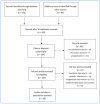Increasing Rural Recruitment and Retention through Rural Exposure during Undergraduate Training: An Integrative Review
- PMID: 32899356
- PMCID: PMC7503328
- DOI: 10.3390/ijerph17176423
Increasing Rural Recruitment and Retention through Rural Exposure during Undergraduate Training: An Integrative Review
Abstract
Objectives: Ensuring nationwide access to medical care challenges health systems worldwide. Rural exposure during undergraduate medical training is promising as a means for overcoming the shortage of physicians outside urban areas, but the effectiveness is widely unknown. This integrative review assesses the effects of rural placements during undergraduate medical training on graduates' likelihood to take up rural practice. Methods: The paper presents the results of a longitudinal review of the literature published in PubMed, Embase, Google Scholar and elsewhere on the measurable effects of rural placements and internships during medical training on the number of graduates in rural practice. Results: The combined database and hand search identified 38 suitable primary studies with rather heterogeneous interventions, endpoints and results, mostly cross-sectional and control studies. The analysis of the existing evidence exhibited predominantly positive but rather weak correlations between rural placements during undergraduate medical training and later rural practice. Beyond the initial scope, the review underpinned rural upbringing to be the strongest predictor for rural practice. Conclusions: This review confirms that rural exposure during undergraduate medical training to contributes to recruitment and retention in nonurban settings. It can play a role within a broader strategy for overcoming the shortage of rural practitioners. Rural placements during medical education turned out to be particularly effective for rural-entry students. Given the increasing funding being directed towards medical schools to produce graduates that will work rurally, more robust high-quality research is needed.
Keywords: curriculum; integrative review; medical workforce; recruitment and retention; rural exposure; rural placement; rural practice; undergraduate medical training.
Conflict of interest statement
The author declares no conflict of interest
Similar articles
-
A decade of Australian Rural Clinical School graduates--where are they and why?Rural Remote Health. 2012;12:1937. Epub 2012 Mar 6. Rural Remote Health. 2012. PMID: 22394086
-
Outcomes of Australian rural clinical schools: a decade of success building the rural medical workforce through the education and training continuum.Rural Remote Health. 2015 Jul-Sep;15(3):2991. Epub 2015 Sep 16. Rural Remote Health. 2015. PMID: 26377746
-
Does the positive influence of an undergraduate rural placement persist into postgraduate years?Rural Remote Health. 2012;12:2011. Epub 2012 Jun 19. Rural Remote Health. 2012. PMID: 22713111
-
A review of characteristics and outcomes of Australia's undergraduate medical education rural immersion programs.Hum Resour Health. 2018 Jan 31;16(1):8. doi: 10.1186/s12960-018-0271-2. Hum Resour Health. 2018. PMID: 29386024 Free PMC article. Review.
-
Mapping the interprofessional education landscape for students on rural clinical placements: an integrative literature review.Rural Remote Health. 2018 May;18(2):4336. doi: 10.22605/RRH4336. Epub 2018 May 4. Rural Remote Health. 2018. PMID: 29724107 Review.
Cited by
-
Rural doctor quota students in Germany - who are they? Data on first year students from two cohorts in the federal state of Saxony.Med Educ Online. 2025 Dec;30(1):2497325. doi: 10.1080/10872981.2025.2497325. Epub 2025 May 6. Med Educ Online. 2025. PMID: 40329552 Free PMC article.
-
Factors associated with medical students' career choice in different specialties: a multiple cross-sectional questionnaire study at a German medical school.BMC Med Educ. 2024 Jul 24;24(1):798. doi: 10.1186/s12909-024-05751-1. BMC Med Educ. 2024. PMID: 39049024 Free PMC article.
-
Understanding the Procedural Skills Needed in Rural Pediatric Practices: A Survey of Rural Pediatric Providers in the State of New Mexico.J Med Educ Curric Dev. 2024 Feb 7;11:23821205241229772. doi: 10.1177/23821205241229772. eCollection 2024 Jan-Dec. J Med Educ Curric Dev. 2024. PMID: 38327826 Free PMC article.
-
Non-Official Language Concordance in Urban Canadian Medical Practice: Implications for Care during the COVID-19 Pandemic.Healthc Policy. 2021 May;16(4):84-96. doi: 10.12927/hcpol.2021.26497. Healthc Policy. 2021. PMID: 34129480 Free PMC article.
-
Reflecting on 12 years of training medical students in rural longitudinal integrated clerkships.Afr J Prim Health Care Fam Med. 2024 Apr 22;16(1):e1-e4. doi: 10.4102/phcfm.v16i1.4390. Afr J Prim Health Care Fam Med. 2024. PMID: 38708731 Free PMC article.
References
-
- WHO . Increasing Access to Health Workers in Remote and Rural Areas through Improved Retention. Global Policy Recommendations. World Health Organization; Geneva, Switzerland: 2010. [(accessed on 23 May 2020)]. Available online: http://whqlibdoc.who.int/publications/2010/9789241564014_eng.pdf. - PubMed
-
- Herrmann M., Hänel P., Jansen E. Yearbook for Critical Medicine and Health Sciences [Jahrbuch für Kritische Medizin und Gesundheitswissenschaften] 50. Argument Publishing House; Hamburg, Germany: 2014. Landärztliche Ausbildung zur Reduzierung der medizinischen Unterversorgung auf dem Land–Erfahrungen, Chancen, Widrigkeiten [Rural medical training to reduce medical undersupply in rural areas-experiences, chances, adversities] pp. 144–172.
-
- Veitch C., Underhill A., Hays R.B. The career aspirations and location intentions of James Cook University’s first cohort of medical students: A longitudinal study at course entry and graduation. Rural Remote Health. 2006;6:537. - PubMed
-
- Larkins S.L., Michielsen K., Iputo J., Elsanousi S., Mammen M., Graves L., Willems S., Cristobal F.L., Samson R., Ellaway R., et al. Impact of selection strategies on representation of underserved populations and intention to practise: International findings. Med. Educ. 2014;49:60–72. doi: 10.1111/medu.12518. - DOI - PubMed
Publication types
MeSH terms
LinkOut - more resources
Full Text Sources
Medical


